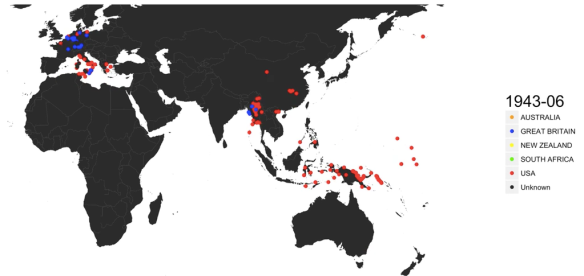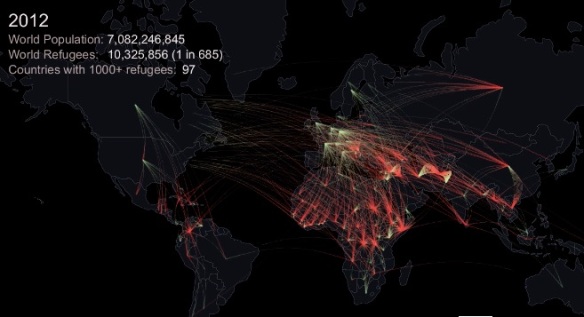 The Disorder of Things has hosted a symposium on Antoine Bousquet‘s The eye of war: military perception from the telescope to the drone (Minnesota UP, 2018). Antoine’s introduction is here.
The Disorder of Things has hosted a symposium on Antoine Bousquet‘s The eye of war: military perception from the telescope to the drone (Minnesota UP, 2018). Antoine’s introduction is here.
There were four other participants, and below I’ve linked to their commentaries and snipped extracts to give you a sense of their arguments: but it really is worth reading them in full.
Kate Hall, ‘Linear Perspective, the Modern Subject, and the Martial Gaze’
For Bousquet this future of globalised targeting that the birth of linear perspective has brought us to throws the role of the human into question. With the move of perception into the realm of the technical, Bousquet sees that perception has become a process without a subject, and as human agency is increasingly reduced, so does the possibility for politics – leading, perhaps much like the concerns of the Frankfurt School, to passivity and a closing of the space of critique. For Bousquet the figure that captures this positioning or transformation of the human, and the image that ends the book, is the bomber instructor recording aircraft movement within a dark camera obscura tent. As Bousquet concludes, “…the camera obscura’s occupant is both a passive object of the targeting process and an active if compliant agent tasked with the iterative process and optimization of its performance. Perhaps this duality encapsulates the martial condition we inhabit today, caught between our mobilization within the circulatory networks of the logistics of perception and the roving crosshairs of a global imperium of targeting – and all watched over by machines of glacial indifference.”
If this is the figure that encapsulates the condition of the present, Bousquet has shown in Eye of War how its foundations are found in the early modern period. And in tracing this history, it is clear the future does not look promising for humans (both as passive subjects and as objects of lethal surveillance). But Bousquet does not give us a sense of how we might change course. Eye of War does not ask, where is the space for politics in this analysis of the present?
Dan Öberg, ‘Requiem for the Battlefield’
While the culminating battle of the Napoleonic wars, Waterloo, was fought at a battlefield where 140,000 men and 400 guns were crammed into an area of roughly 3,5 miles, the latter half of the 19th century becomes characterised by the dispersal and implosion of the battlefield. As Bousquet has directed our attention to in his work, after the birth of modern warfare the battlefield dissolves due to the increased range of weapons systems. Its disappearance is also facilitated by how the military logistics of perception conditions the appearances of targets, particularly through how the “eye of war” manages to move from the commander occupying a high-point next to the field of battle, to being facilitated by balloons, binoculars, aerial reconnaissance, satellites, algorithms, and cloud computing. It is as part of this process we eventually reach the contemporary era where targeting is characterised by polar inertia, as targets arrive as digital images from anywhere on the globe in front of a stationary targeteer. However, I would like to argue that, parallel to this, there is a corresponding process taking place, which erases and remodels the battlefield as a result of the military disposition that is born with the operational dimension of warfare.
To grasp this disposition and its consequences we need to ponder the fact that it is no coincidence that the operational dimension emerges at precisely the time when the traditional battlefield is starting to disappear. As The Eye of War outlines, global targeting is enabled by a logistics of perception. However, the demand for maps and images as well as the attempts to make sense of the battlefield arguably receives its impetus and frame of reference from elsewhere. It finds its nexus in standard operating procedures, regulations, instructions and manuals, military working groups, administrative ideals, organisational routines, and bureaucratic rituals. And, as the battlefield is managed, coded, and homogenised, it simultaneously starts to become an external point of reference, enacted through operational analysis and planning far from the battlefield itself.
Matthew Ford, ‘Totalising the State through Vision and War’
The technologies of vision that Antoine describes emerge from and enable the political and military imaginaries that inspired them. The technological fix that this mentality produces is, however, one that locks military strategy into a paradox that privileges tactical engagement over identifying political solutions. For the modern battlefield is a battlefield of fleeting targets, where speed and concealment reduce the chance of being attacked and create momentary opportunities to produce strategic effects (Bolt, 2012). The assemblages of perspective, sensing, imaging and mapping, described in The Eye of War may make it possible to anticipate and engage adversaries before they can achieve these effects but by definition they achieve these outcomes at the tactical level.
The trap of the martial gaze is, then, twofold. On the one hand, by locking technologies of vision into orientalist ways of seeing, strategies that draw on these systems tend towards misrepresenting adversaries in a manner that finds itself being reproduced in military action. At the same time, in an effort to deliver decisive battle, the state has constructed increasingly exquisite military techniques. These hold out the prospect of military success but only serve to further atomise war down tactical lines as armed forces find more exquisite ways to identify adversaries and adversaries find more sophisticated ways to avoid detection. The result is that the military constructs enemies according to a preconceived calculus and fights them in ways that at best manage outcomes but at worst struggle to deliver political reconciliation.
Jairus Grove, ‘A Martial Gaze Conscious of Itself’
If we take the assemblage and the more-than-human approach of Bousquet’s book seriously, which I do, then we ought not believe that the dream of sensing, imaging, mapping, and targeting ends with the intact human individual. As an early peak at what this could become, consider Bousquet’s review of the late 1970’s research on ‘cognitive cartography’ and the concern that human technology would need to be altered to truly take advantage of the mapping revolution. More than the development of GIS and other targeting technologies, the dream of cognitive mapping and conditioning was to manage the complex informatics of space and the human uses of it from the ground up. That is in the making of user-friendly human subjects. One can image targeting following similar pathways. The “martial gaze that roams our planet” will not be satisfied with the individual any more than it was satisfied with the factory, the silo, the unit, or the home.
The vast data revolutions in mapping individual and collective behavior utilized in the weaponization of fake and real news, marketing research, fMRI advances and brain mapping, as well nanodrones, directed energy weapons, and on and on, suggest to me that just as there has never been an end of history for politics, or for that matter war, there will be no end of history or limit to what the martial gaze dreams of targeting. I can imagine returns to punishment where pieces of the enemy’s body are taken. Jasbir Puar’s work on debility suggests (see our recent symposium) already suggests such a martial vision of the enemy at play in the new wars of the 21st century. Following the long tails of Bousquet’s machinic history, I can further imagine the targeting of ideas and behaviors for which ‘pattern-of-life’ targeting and gait analysis are use are only crude and abstract prototypes.
If we, like the machines we design, are merely technical assemblages, then the molecularization of war described by Bousquet is not likely to remain at the level of the intact human, as if individuals were the martial equivalent of Plank’s quanta of energy. The martial gaze will want more unless fundamentally interrupted by other forces of abstraction and concretization.
Antoine‘s response is here.
Lots to think about here for me – especially since one of my current projects on ‘woundscapes‘ (from the First World War through to the present) is located at the intersection of the military gaze (‘the target’) and the medical gaze (‘the wound’) but rapidly spirals beyond these acutely visual registers, as it surely must…. More soon!

































